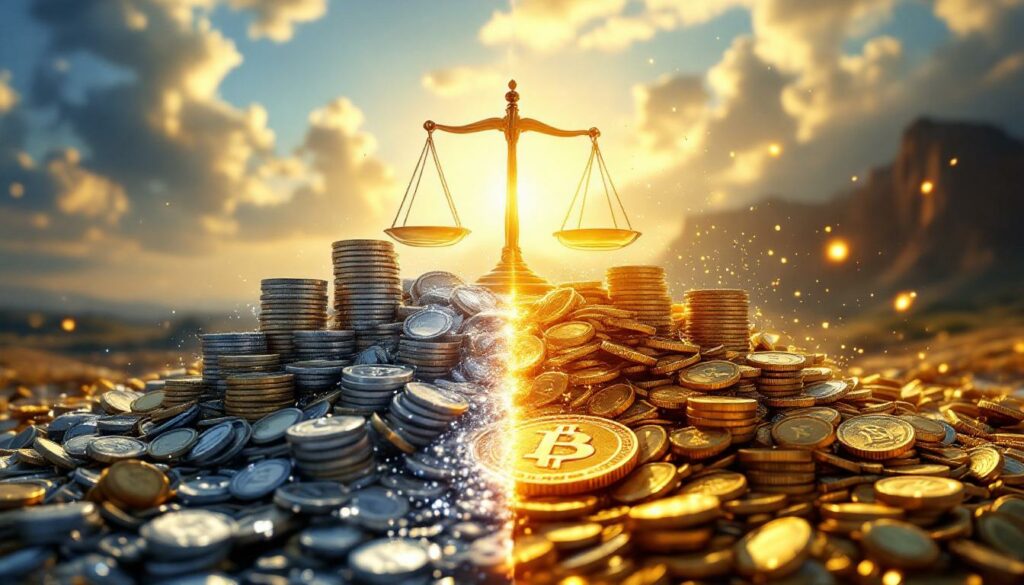What Makes Gold and Silver Legal Tender?
Gold and silver have historically served as money for thousands of years before modern fiat currencies emerged. Legal tender status fundamentally means that a form of payment must be accepted for the settlement of debts when offered. While the U.S. Constitution explicitly references gold and silver coin as payment for debts in Article 1, Section 10, Clause 1, modern interpretations have shifted dramatically.
Today, courts generally classify precious metals as collectibles or personal property rather than currency, creating a legal disconnect between constitutional intent and current practice. Recent gold price forecast trends suggest continued interest in precious metals as alternative assets.
Understanding Legal Tender Status
The concept of legal tender is often misunderstood. When something has legal tender status, creditors must accept it for debt settlement, but private businesses can still refuse it for goods and services. The U.S. dollar gained its legal tender status through government decree rather than market forces, while gold and silver historically earned monetary status through voluntary adoption across civilizations.
As Danielle Diaz from Citizens for Sound Money explains: "The U.S. Constitution gives states the authority to recognize gold and silver as money, but federal tax laws treat them as commodities. Our movement seeks to restore their constitutional role."
The Constitutional Foundation
The U.S. Constitution specifically limits what states can designate as legal tender in Article 1, Section 10, Clause 1, stating that "No State shall… make anything but gold and silver coin a tender in payment of debts." This constitutional provision has become the legal foundation for the modern sound money movement.
This clause wasn't merely a suggestion—it was a deliberate restriction on state powers following the economic chaos caused by paper currencies during the Revolutionary War period. The Founders had witnessed firsthand how unbacked currencies could devastate economies and sought to prevent future abuses.
Differences Between Money and Currency
True money serves three critical functions: store of value, medium of exchange, and unit of account. Most importantly, genuine money maintains purchasing power over time—something gold and silver have demonstrated for millennia.
Gold and silver possess intrinsic value due to their natural scarcity, durability, divisibility, and universal recognition. These metals cannot be created artificially at scale, unlike modern currencies which are debt instruments created by central banks and governments.
Modern currencies are designed with built-in inflation that gradually erodes purchasing power. When the Federal Reserve creates new dollars, it dilutes the value of existing dollars—similar to how a company issuing new stock dilutes existing shareholders. This fundamental difference explains why precious metals analysis often shows they have preserved wealth across generations while fiat currencies consistently lose value.
Why Is There a Movement Toward Sound Money?
The sound money movement has gained significant momentum in recent years, driven by growing concerns about inflation, financial surveillance, and economic instability. As more people recognize the vulnerabilities in the current monetary system, interest in alternatives has surged.
Economic Protection Against Inflation
The primary driver behind the sound money movement is protection against inflation. Since the Federal Reserve's creation in 1913 and especially since abandoning the gold standard in 1971, the U.S. dollar has lost over 97% of its purchasing power according to Federal Reserve Economic Data (FRED).
This isn't merely an abstract concept—it affects real people daily. As Danielle Diaz poignantly observed: "The 94-year-old woman who outlived her savings isn't an outlier—she's a symptom of a system designed to erode economic energy."
A striking example comes from a 78-year-old Uber driver in Florida who, despite receiving social security and having retirement savings, couldn't afford basic necessities without continuing to work. This reality reflects a broader trend—a 2023 PYMNTS/LendingClub report found that 78% of Americans now live paycheck-to-paycheck, regardless of income level.
Preserving Economic Energy
Sound money advocates view labor and productivity as forms of "economic energy" that should be preserved through stable money. When people work, they convert their time, knowledge, and skills into monetary value—essentially storing their economic output.
Fiat currencies systematically diminish this stored economic energy through inflation, while precious metals preserve it across generations. This preservation ability explains why a gold coin from ancient Rome could still buy approximately the same amount of goods today as it could 2,000 years ago, while Roman paper currency became worthless.
Financial Privacy and Freedom
As digital surveillance of financial transactions increases, physical gold and silver offer a level of privacy that electronic payments cannot. The ability to conduct transactions outside the banking system provides a hedge against potential financial censorship, account freezes, or "debanking" that has affected various individuals and businesses.
A 2023 industry survey revealed that approximately 40% of U.S. banks now refuse accounts to precious metals dealers, highlighting the growing challenges faced by those in the sound money space. This financial gatekeeping has pushed many to seek alternatives outside traditional banking.
Protection Against Economic Instability
With U.S. national debt exceeding $37 trillion and global derivatives markets in the hundreds of trillions, sound money advocates view physical precious metals as insurance against potential financial system disruptions. Gold investment amid inflation has become increasingly popular as a strategy to hedge against economic uncertainty.
Throughout history, gold and silver have maintained their value through wars, depressions, and currency collapses. This historical performance explains why central banks worldwide have been increasing their gold reserves since 2008—they recognize its importance as a hedge against systemic risk.
How Are States Making Gold and Silver Legal Tender?
The sound money movement has strategically focused on state-level legislation as the most effective path toward monetary reform. This approach leverages the constitutional authority granted to states while creating a grassroots foundation for broader change.
The State-Level Legislative Approach
As of 2024, approximately 20% of U.S. states have passed laws recognizing gold and silver as legal tender, according to Citizens for Sound Money. Florida, Idaho, Alabama, and Missouri are the most recent additions, joining Utah, Wyoming, Texas, and others that previously enacted similar legislation.
These laws vary in scope but generally aim to:
- Recognize gold and silver as legal tender within state boundaries
- Remove tax barriers to using precious metals as money
- Create regulatory frameworks for gold-backed payment systems
- Establish state depositories for precious metals
This state-by-state approach creates "monetary competition zones" where citizens can choose between fiat currency and precious metals for transactions and savings. As states adopt gold and silver as legal tender, the movement continues to gain momentum across the country.
Removing Tax Barriers
A key component of sound money legislation involves removing tax barriers that treat precious metals as commodities rather than money. These include:
- Eliminating state sales taxes on precious metals purchases (now in 12 states according to Money Metals Exchange)
- Removing capital gains taxes on gold and silver transactions at the state level
- Creating tax incentives for in-state precious metals depositories and businesses
These tax changes are critical because they address a fundamental contradiction: if gold and silver are money (as the Constitution suggests), they shouldn't be taxed when exchanged for other forms of money.
Electronic Transfer Frameworks
The most innovative aspect of recent legislation, particularly in Florida, Arkansas, and Missouri, is the creation of regulatory frameworks for the electronic transfer of gold and silver ownership. These frameworks allow digital gold platforms to register as money service businesses and custodians, enabling electronic gold-backed payments while maintaining consumer protections.
Danielle Diaz explains: "Florida's framework lets companies like Kinesis operate as money transmitters, bridging blockchain and traditional finance." This regulatory clarity provides legal certainty for businesses and consumers while ensuring adequate safeguards.
State Depositories and Reserves
Some states have established state bullion depositories and are exploring holding precious metals as reserve assets. Texas created the Texas Bullion Depository in 2018, operated under the authority of the Texas Comptroller, to serve both private citizens and state institutions.
These depositories provide secure storage for precious metals while potentially allowing state agencies, pension funds, and municipalities to diversify their reserves beyond traditional financial assets. This approach reduces reliance on the federal banking system while keeping precious metals within state borders.
What Makes Florida's Sound Money Law Groundbreaking?
Florida's recent legislation represents a significant leap forward for the sound money movement, establishing a comprehensive framework that could serve as a model for other states and even countries.
First Major Economy to Adopt Digital Gold Framework
Florida's recent legislation makes it the largest economy (equivalent to the world's 14th largest if it were a country, according to World Bank data) to recognize gold and silver as legal tender. The law establishes a comprehensive regulatory framework for electronic gold and silver transfers, potentially transforming how Floridians can use precious metals in everyday transactions.
The scale of Florida's economy makes this move particularly significant—with a GDP exceeding $1.2 trillion, it represents a market large enough to establish viable monetary alternatives that could influence broader adoption. Record gold prices have further increased interest in precious metals as legal tender alternatives.
Regulatory Framework for Digital Gold Providers
The Florida law requires the Office of Financial Regulation to establish rules for companies offering gold-backed digital currencies. These companies must register as money services businesses and custodians, creating consumer protections while allowing innovation in the digital gold space.
Key requirements include:
- Mandatory third-party audits (by firms like Bureau Veritas)
- 100% physical backing of all digital tokens
- Consumer protection provisions
- Anti-money laundering compliance
- Regular reporting and transparency measures
This balanced approach provides consumer protection without stifling innovation, creating clarity for businesses entering the space.
Implementation Timeline
While the law has been signed, it includes a phased implementation approach:
- The law was signed in May 2024
- The Office of Financial Regulation must submit regulatory framework details by November 1, 2024
- Full implementation is scheduled for July 1, 2025, though efforts are underway to accelerate this timeline to April 2024
This gradual rollout allows businesses and regulators to adapt while providing certainty about future legal status.
Potential Economic Impact
By eliminating sales tax on precious metals and creating a pathway for electronic gold transactions, Florida's law could position the state as a hub for precious metals businesses and financial technology companies focused on asset-backed digital currencies.
According to Goldback Inc., over 5,000 Florida businesses already accept gold-denominated notes, indicating existing demand for precious metals payments. The removal of tax barriers and regulatory clarity could accelerate this adoption significantly, potentially creating a parallel monetary ecosystem within the state.
How Does Blockchain Technology Enhance Gold as Money?
The integration of blockchain technology with physical gold represents a transformative development for sound money, addressing historical limitations while preserving core values.
The Marriage of Ancient Money and Modern Technology
Blockchain technology solves a historical limitation of physical gold: its difficulty in small-scale division and digital transfer. By creating immutable digital records of gold ownership, blockchain enables gold to function in the digital economy while maintaining its physical backing.
This technological advancement allows gold to compete with modern payment systems while retaining its intrinsic value and scarcity—combining the best of both worlds.
Proof of Ownership and Immutability
The blockchain creates an unalterable record of ownership that cannot be manipulated by governments or third parties. This immutability provides security against confiscation or disputed ownership, addressing vulnerabilities that have historically affected physical property rights.
As Danielle Diaz notes: "Blockchain's immutability solves gold's historical flaw—it can't be confiscated or inflated." This protection against seizure represents a significant advancement over previous gold-backed monetary systems, which often relied on centralized storage vulnerable to government confiscation.
Fractional Ownership and Micropayments
Digital gold platforms allow ownership of gold in tiny increments—as small as 50 milligrams according to the Kinesis Monetary System—making precious metals accessible to people of all economic levels. This fractional ownership enables micropayments and everyday transactions that would be impractical with physical gold coins or bars.
This divisibility democratizes access to precious metals, allowing individuals to start with minimal investments while participating in the same monetary system as large institutions.
Transparency Through Auditing
Leading digital gold platforms implement regular third-party audits to verify that all digital tokens are fully backed by physical gold and silver in secure vaults. Companies like Kinesis partner with firms such as Bureau Veritas and BDO International for monthly attestations of their precious metals holdings.
This transparency addresses historical concerns about fractional reserve practices that undermined previous gold-backed currencies. The 1933 gold confiscation in the United States occurred partly because banks were operating on fractional reserves—a vulnerability that modern audit protocols can prevent.
Global Accessibility
Digital gold platforms can serve the estimated 1.4 billion unbanked adults worldwide who have mobile phones but lack traditional banking services, according to the World Bank Findex 2021 report. This technology enables global peer-to-peer transfers of gold-backed value without the high fees typically associated with international remittances.
Some platforms like Kinesis have developed yield systems where users earn returns in gold for transacting via the platform, creating additional incentives for adoption. This model provides passive income opportunities previously unavailable to physical gold holders.
Who Benefits From Gold and Silver as Legal Tender?
The sound money movement potentially benefits diverse groups across the economic spectrum, from retirees to the unbanked, small businesses to international traders.
Protection for Retirees and Fixed-Income Individuals
Elderly individuals on fixed incomes are particularly vulnerable to inflation. A 78-year-old Uber driver in Missouri shared that despite social security and retirement savings, she couldn't afford basic necessities without continuing to work. Preserving purchasing power through sound money could help protect retirees from outliving their savings.
Inflation essentially functions as an invisible tax that disproportionately affects those without the ability to increase their income. By providing a stable store of value, gold and silver offer protection that traditional retirement vehicles often lack.
Economic Opportunity for the Unbanked
The World Bank estimates that about 1.4 billion adults remain unbanked globally. Digital gold platforms that operate on mobile phones can provide financial services to these individuals without requiring traditional banking infrastructure, potentially lifting millions out of poverty through financial inclusion.
This approach bypasses the need for extensive physical infrastructure, allowing developing regions to adopt sophisticated financial tools through mobile technology—similar to how many countries skipped landline telephones and moved directly to mobile communications.
Small Business Payment Options
Businesses accepting gold and silver gain an alternative payment method that doesn't involve credit card processing fees (typically 2-3% of transactions). Some businesses already accept physical gold products like Goldbacks or digital gold currencies, diversifying their revenue streams and hedging against inflation.
This payment diversification can be particularly valuable during economic disruptions when traditional payment systems may face limitations or outages. Having multiple accepted forms of payment provides resilience that single-system dependence lacks.
International Trade Without Currency Risk
Companies engaged in international trade face currency exchange risks and costs. Gold-backed payment systems could provide a neutral international medium of exchange that isn't subject to the monetary policies of any single nation, potentially reducing costs and risks in global commerce.
This advantage becomes particularly significant during periods of currency volatility or when dealing with countries experiencing high inflation rates. A gold-backed payment method provides stability that traditional currency exchanges often cannot guarantee.
What Challenges Does the Sound Money Movement Face?
Despite growing momentum, the sound money movement faces significant obstacles to widespread adoption and recognition.
Federal Tax Treatment
While states can eliminate sales taxes on precious metals, federal capital gains taxes remain a significant barrier to widespread adoption. Every transaction involving gold or silver can potentially trigger a taxable event under current IRS rules, making everyday use impractical for many.
IRS Publication 550 specifies that precious metals are taxed as collectibles at a 28% rate—significantly higher than the 15% long-term capital gains rate applied to most financial assets. This disparate treatment creates a substantial disincentive for using gold and silver as transactional media.
Banking System Integration
Traditional banks have been hesitant to work with precious metals businesses, sometimes closing accounts of companies in the industry. Full integration with the existing financial system will require regulatory clarity and banking partnerships to bridge the gap between conventional finance and sound money.
The 2023 industry survey showing 40% of U.S. banks refusing accounts to precious metals dealers highlights this challenge. Without reliable banking relationships, scaling precious metals businesses becomes significantly more difficult.
Public Education Barriers
Financial literacy regarding sound money principles is limited in most educational systems. Many Americans don't understand the difference between money and currency or how inflation erodes purchasing power over time. The sound money movement faces the challenge of educating the public about monetary history and principles.
This education gap creates significant hurdles for adoption, as many potential users lack the conceptual framework to understand the benefits of sound money. Overcoming these knowledge barriers requires substantial educational initiatives beyond legislative reforms.
Technological Adoption Hurdles
While younger generations readily adopt digital payment technologies, older individuals who might benefit most from inflation protection may be less comfortable with digital gold platforms. Bridging this technological divide remains a challenge for widespread adoption.
This generational gap creates a paradox: those most vulnerable to inflation (retirees) may be the least likely to adopt the technological tools designed to protect them. Creating user-friendly interfaces and educational resources becomes crucial for reaching this demographic.
How Might Sound Money Impact the Global Financial System?
The growing adoption of gold and silver as legal tender could have far-reaching implications for the global financial system. Understanding the [gold-silver ratio analysis](https://discoveryalert.com.au/news/gol
Looking to Stay Ahead of the Next Major Mineral Discovery?
Discovery Alert's proprietary Discovery IQ model instantly identifies significant ASX mineral discoveries, delivering real-time alerts that transform complex data into actionable investment opportunities. Explore how historic discoveries have generated substantial returns by visiting our dedicated discoveries page and begin your 30-day free trial today to secure your market advantage.




